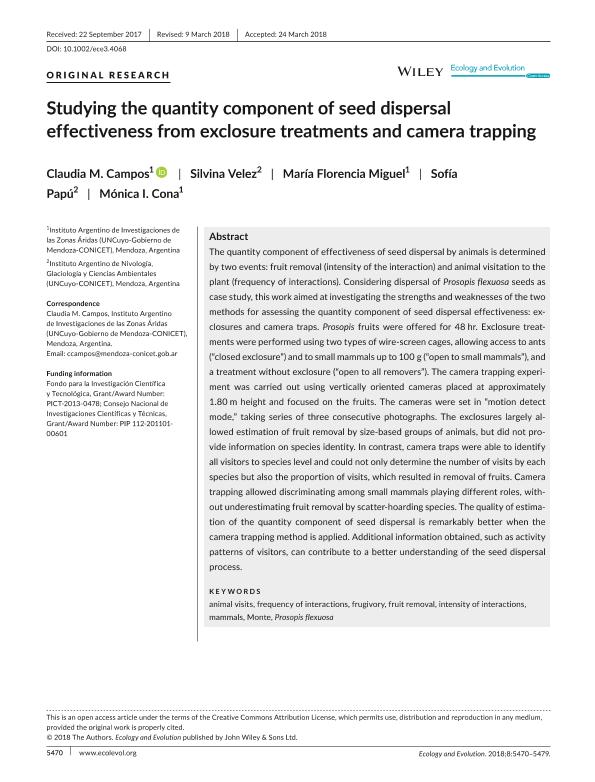Artículo
Studying the quantity component of seed dispersal effectiveness from exclosure treatments and camera trapping
Fecha de publicación:
06/2018
Editorial:
John Wiley & Sons Ltd
Revista:
Ecology and Evolution
ISSN:
2045-7758
Idioma:
Inglés
Tipo de recurso:
Artículo publicado
Clasificación temática:
Resumen
The quantity component of effectiveness of seed dispersal by animals is determined by two events: fruit removal (intensity of the interaction) and animal visitation to the plant (frequency of interactions). Considering dispersal of Prosopis flexuosa seeds as case study, this work aimed at investigating the strengths and weaknesses of the two methods for assessing the quantity component of seed dispersal effectiveness: exclosures and camera traps. Prosopis fruits were offered for 48 hr. Exclosure treatments were performed using two types of wire-screen cages, allowing access to ants (“closed exclosure”) and to small mammals up to 100 g (“open to small mammals”), and a treatment without exclosure (“open to all removers”). The camera trapping experiment was carried out using vertically oriented cameras placed at approximately 1.80 m height and focused on the fruits. The cameras were set in “motion detect mode,” taking series of three consecutive photographs. The exclosures largely allowed estimation of fruit removal by size-based groups of animals, but did not provide information on species identity. In contrast, camera traps were able to identify all visitors to species level and could not only determine the number of visits by each species but also the proportion of visits, which resulted in removal of fruits. Camera trapping allowed discriminating among small mammals playing different roles, without underestimating fruit removal by scatter-hoarding species. The quality of estimation of the quantity component of seed dispersal is remarkably better when the camera trapping method is applied. Additional information obtained, such as activity patterns of visitors, can contribute to a better understanding of the seed dispersal process.
Archivos asociados
Licencia
Identificadores
Colecciones
Articulos(IADIZA)
Articulos de INST. ARG DE INVEST. DE LAS ZONAS ARIDAS
Articulos de INST. ARG DE INVEST. DE LAS ZONAS ARIDAS
Citación
Campos, Claudia Monica; Velez, Silvina; Miguel, María Florencia; Papú, Sofía; Cona, Monica Ines; Studying the quantity component of seed dispersal effectiveness from exclosure treatments and camera trapping; John Wiley & Sons Ltd; Ecology and Evolution; 8; 11; 6-2018; 5470-5479
Compartir
Altmétricas




